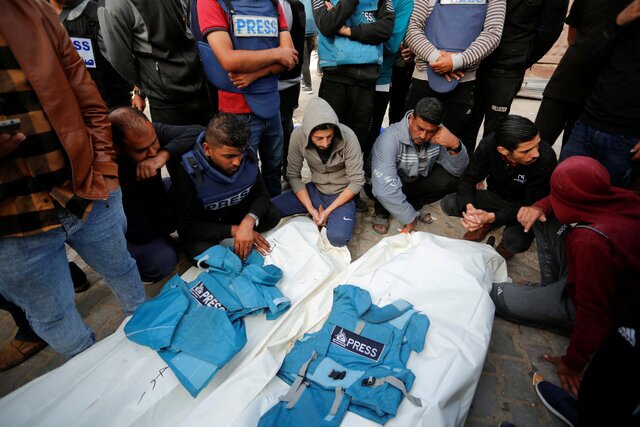Why are so many journalists being killed in Gaza
As the number of journalists and media workers killed by the Israeli military in the enclave has risen to 109, many experts have reached another conclusion. The regime has censored its own media from displaying any footage of the Gaza Strip that has been reduced to rubble.

Why are so many journalists being killed in Gaza?
As the number of journalists and media workers killed by the Israeli military in the enclave has risen to 109, many experts have reached another conclusion. The regime has censored its own media from displaying any footage of the Gaza Strip that has been reduced to rubble.
The settler population will put pressure on the Netanyahu government to end the war if they realize that the army has failed to win over Hamas or recover Israeli captives despite killing 1% of the Gazans and flattening entire neighborhoods.
Foreign journalists have been largely forbidden by the regime from entering the enclave at their own free will. They have only done so very rarely in carefully calculated Israeli military tours.
Western journalists, in particular, have been prevented as they would naturally interview the displaced residents of Gaza, travel through the enclave, and begin to observe and report about the regime's war crimes in the territory.
Speaking at his son’s funeral, Wael al Dahdouh, a veteran journalist, said, "To Hamza and to all the martyrs I say we will remain faithful. This is the road that we have chosen consciously. We have offered much, and we have offered a lot of blood because this is our destiny. We shall continue." This would essentially spin the narrative of the Western media about the reality of what is unfolding in Gaza.
The only lifeline of information reaching the outside world is the brave work of local journalists and those who had been stationed in Gaza by regional media outlets before the war started.
This is the only source to counter the disinformation campaign that the regime is waging and is trying its very best to kill this source.
According to the Gaza Media Center?, the regime has killed 109 journalists and media workers in the enclave, over the past three months, turning the blockaded territory into the most dangerous place in the world to work in such a profession.
Moreover, the regime has used surgical strikes to destroy the Gaza media offices of some of the most well-known regional media outlets.
These are the same news outlets that are using their cameras to highlight just part of the killings and destructions that the Israeli military is committing in Gaza.
The media has become the number one enemy of the regime, which is trying its best to silence the information getting out of Gaza.
To silence the media in Gaza, the occupation regime has also cut communications in the enclave so that live bloggers who connect with the outside world and speak about the latest developments are prevented from doing so as internet services continue to go down on a regular basis.
UN workers can speak out against the regime for the most heinous crimes it is committing in Gaza, which they have been reporting on, but streaming live images from the Strip is a totally different ball game.
The Israeli regime has killed some of the most well-known and veteran Gaza journalists trusted by the people in the region. Some have been killed by airstrikes and others on the battlefield by the Israeli military that has invaded the enclave.
This is despite the fact that journalists wear a bright blue flak jacket with PRESS written on it as well as a bright blue helmet with PRESS clearly written on it to identify themselves. They are non-combatants.
An analysis by the International Federation of Journalists last month said that during the first 10 weeks of the Israeli war on Gaza alone, more journalists had been killed in the enclave than in any other country in history over an entire year.
Reports have also emerged of other journalists going missing, detained, hurt, threatened, or intentionally their homes have been damaged.
The Committee to Protect Journalists said it was "particularly concerned about an apparent pattern of targeting of journalists and their families by the Israeli military."
